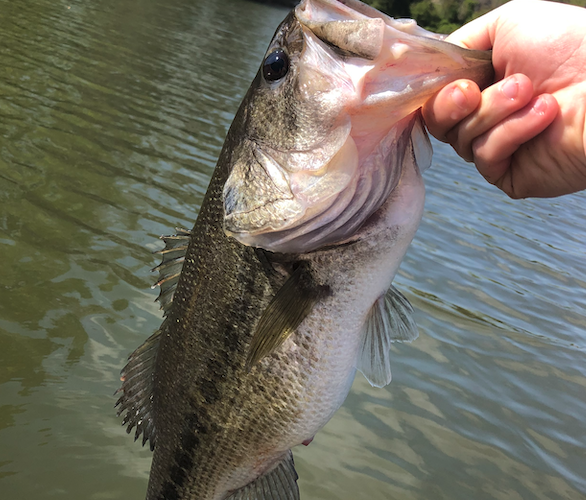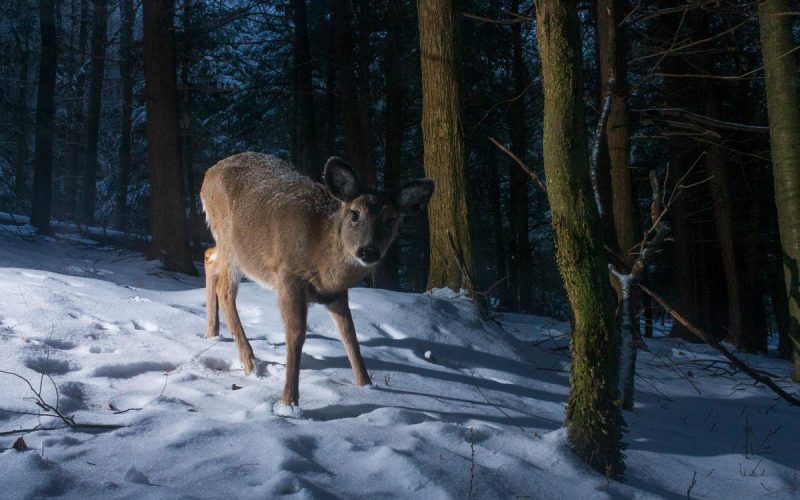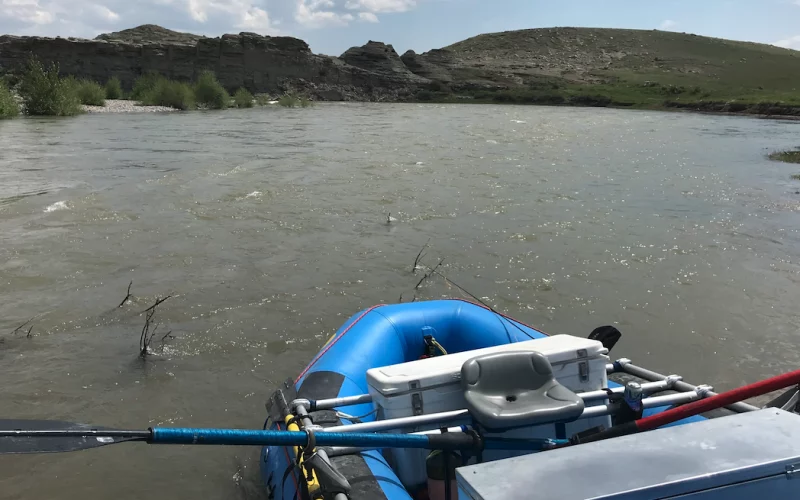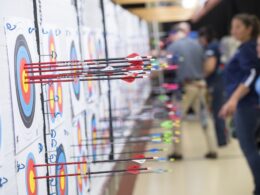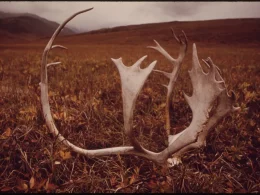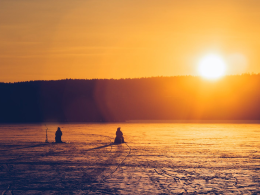It’s the most exciting time of the year for bass fishing. The pre-spawn, spawn, and post-spawn periods can all yield productive days on the water. However, each of these periods has its own tactics and flies that will bring the best results.
Table of Contents
Pre-Spawn Bass
If you can only fish two weeks out of the whole year, then this is the time to do so. Bass have been hanging out in deep water all winter, snacking on the food they can find. Now that the water has warmed, they know they’ll need the energy for the spawn. So, they spend these next few weeks eating anything and everything that comes in front of their faces.
These are the days when you can not only catch a lot of fish but also a lot of big fish. The pre-spawn occurs at different times across the country. In the south, it may happen as early as March or February. While the northern states might not get it until May or June. The best thing to do is monitor the water temperature. Once the water is in the 48–55-degree range you’ll know that bass are starting to move.
Location
The best way to find these pre-spawners is to locate a good spawning area and then work backward into deeper water. Bass will hang out in the deeper water outside of where they will spawn. They’re waiting for the water temperature to raise and in the meantime, they’re going to eat as much as they can.
Shallow flats or pockets in the back channels of these ponds and lakes are good spawning areas. Work the mouths of these channels and creeks and focus specifically on any type of structure that might be around there. This could be docks, brush piles, or fallen trees.
These are called “staging areas”. Depending on the water clarity they could be hanging out in water that is in the 5’-15’ range in clear water. Or 20-30’ in dark or stained water.
Gear
A 6-8 weight rod will be your best bet for bass fishing year-round. During the pre-spawn, a sinking line or a sink tip line should get your fly down deep enough to where the bass are staging. If you’re fishing clear water and the water temperature is closer to 55 then you might be able to get away with a floating line and 9’ of fluorocarbon or monofilament leader.
There’s a strong chance you’ll also need a boat in order to get to staging fish. A kayak, canoe, or Jon boat will work just fine. If you don’t have access to any of these then look for points near channels. Cast out to the side in the mouth of the channel and work your fly back towards you.
Flies
During those early days of the pre-spawn when the water is still cold, you’ll want to fish the bottom and fish slowly. A leech, crawfish, or a wooly bugger that you drag along the bottom can yield some great results. You can hop these by allowing them to sink and then giving quick strips to make them move quickly. Bass will eat on the drop or when the fly doesn’t move so watch your line carefully and be ready for a strip set.
Clousers, wooly buggers, and other streamer patterns work well as the water warms and the bass are fully staged. The classic strip, strip, pause retrieve is a great place to start. If the fish don’t like that then try smaller strips and longer pauses.
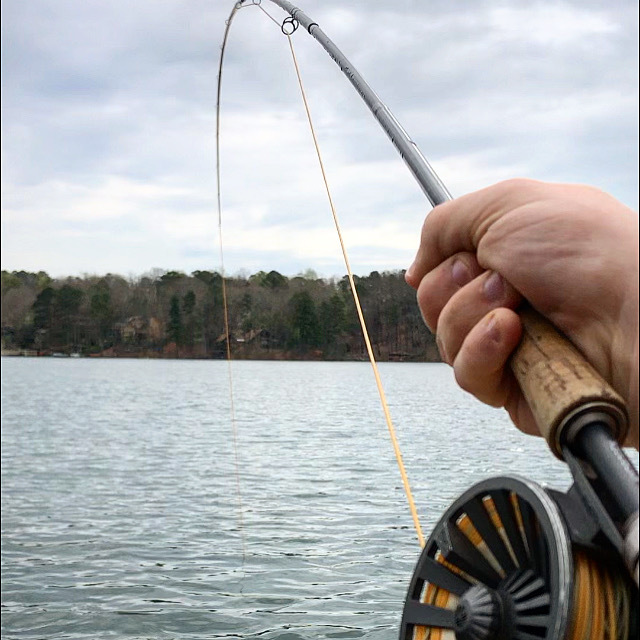
Spawn
This is the time when bass will be on their beds. During this time the males will make a nest about the size of a dinner plate and will protect the bed and eventually the eggs and fry. It can be a fun way to catch fish since you will be sight fishing in shallow water.
Location
As we mentioned above, you’ll want to look in 2-7’ of water in the back of channels and off points for spawning fish. Oftentimes you’ll be able to see the beds in the water. These can be around the size of a dinner plate or larger and can sometimes be in groups.
You’ll need some visibility in order to locate the beds. If your local lake or pond is stained or muddied to the point of zero visibility, then locating beds will be nearly impossible. In situations like this, you’re better off finding a new body of water or just crossing your fingers and fishing the backs of channels slowly.
Gear
A floating line with a mono or fluoro leader will be your best bet. You will not be fishing very deep, usually in only a few feet of water. Polarized sunglasses are a must this time of the year. These will cut the glare off the top of the water and will allow you to see the beds more clearly.
This is the time of year when the shore angler shines. Most of the fish will be in water that is close enough to the bank that you can access it as long as there is enough room for a back cast. If not, you should be able to roll cast to it.
Wading can also be useful this time of the year. Waders and boots can go a long way in keeping you comfortable throughout the day and can also hold all the gear you might need.
Flies
This time of year, the bass are not eating because they’re hungry. They are in protect the nest mode and will only eat if they need to. So, the name of the game during this time of the year is to agitate the bass just enough so that they eat your fly.
During the spawn you can throw just about whatever you want, and as long as you get it close enough to the nest, you’ll find that after enough time the bass will eat it.
Crawfish and wooly buggers are a great place to start though. You’ll want to cast just over or just to the side of the nest. Do your best to prevent your fly line from going over the backs of the fish. This can spook them off the nest and if that happens then you’ve just blown your chance to catch those fish for a while.
Next, you’ll want to slowly drag your fly along the bottom and move it through or just to the side of where the bass is sitting. Chances are they’ll watch it the whole time it’s in the water. They might not pick it up on the first, second, or third pass, so keep trying. Eventually the bass will get tired of seeing this crawfish move past its bed and will eat it. It may take a few tries, but you should eventually be able to land the fish.
Ethics
In the fishing world targeting bass while they’re on their nest has come under some scrutiny. It’s important to keep in mind that the bass sitting on their beds are protecting their eggs or fry. Crimping barbs and being mindful of keeping fish out of the water for as short as possible helps make sure they can get back to their nest quickly and safely.

Post Spawn
Here, we’re going to focus on what the fish will be doing those first few weeks after the spawn is over. Often the bass will head to the first deep point or channel they can find. It’s here they’ll rest and recover from the spawn. They won’t be eating much during this stage, so don’t think that the fishing has completely turned off. They’re simply taking a break.
After this, the fish will split up into two groups. One group will go deep, and the others will go shallow. The group that goes deep will be in larger schools. The shallow group will be spread out among different types of cover.
Location
The fish that have moved deep will be in areas that hold structure or near drop-offs. These fish will be in large schools, and you’ll need either a topographic map of the lake or electronics to find where these bass are schooling.
The shallow-water bass can be found in the backs of channels in areas that have structure. Fallen trees, brush piles, docks, and lily pads are spots to target. Unlike the deep, schooled-up fish, you can catch these on several different flies and tactics.
Gear
If you want to fish deep, then you’ll need a sink tip or sinking line. These fish will be too deep for a long leader to get to. If you want to target shallow, then a floating line with a mono leader will work best.
Ideally, you’ll have both sinking and floating lines with you so you can fish both, but that’s not always possible. You’ll need a boat to target the deep-water fish, but the shallow fish can be caught on land.
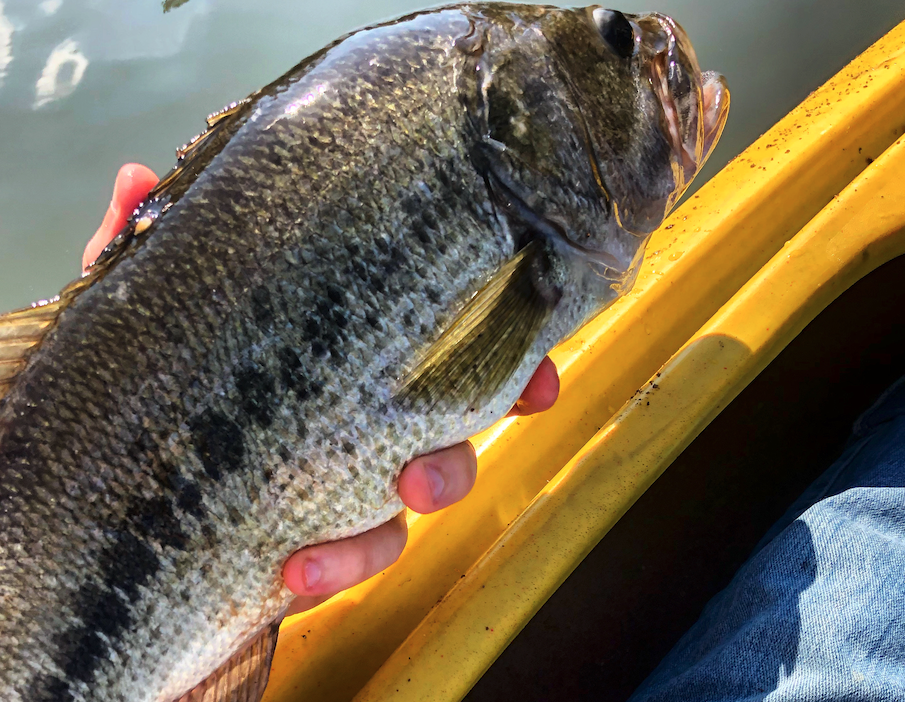
Flies
When looking for the deep-water fish you’ll want to use baitfish imitations. Figure out how deep the bass are and then work your clouser, wooly bugger, slump buster, or gamechanger through the water column. Bring some crawfish too. If the bite is slow then working a crawfish slowly across the bottom or just suspended off the bottom can instigate a strike.
Targeting the shallow water bass will require a larger selection of flies. You can use just about any tactic you want on these fish. Top water is arguably the most fun. Fishing a frog, popper, mouse, or foam body bait fish pattern can result in some explosive strikes.
Those same baitfish flies we mentioned above can also be used on shallow-water fish. Use your floating line set up and work those flies a few feet deep in the water column. Strip, strip, pause is a great retrieve to use.
You can also work your flies across the bottom by hopping them or stripping them slowly. This tactic works great when a cold front has moved through or if the bite is slow.
Work all these flies near or around structure. Remember to cast further out to further in. Casting right on top of a piece of structure could spook a fish. Instead cast about 5-6’ away and then work your way in closer with your next casts.
Conclusion
This is the time of year to go out and catch your personal best or land a limit of bass. The fish are actively feeding and can lead to some of the best days you’ve ever spent on the water.

